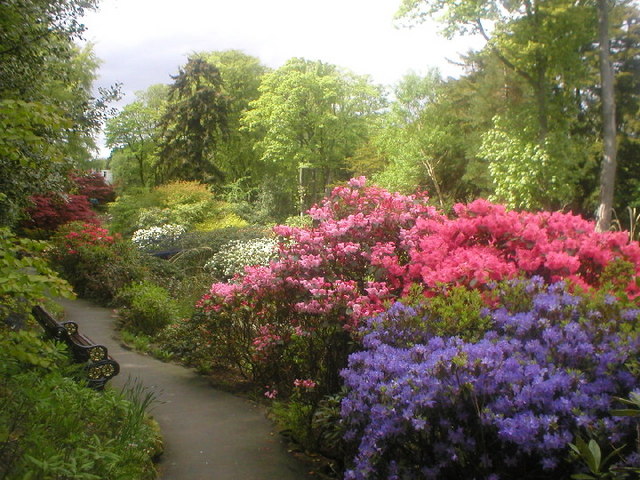Tripatini
the world's smartest travel social network
Keen on Aberdeen, Scotland
 Anastasia Yakovleva
Anastasia Yakovleva
by Inka Piegsa-Quischotte
No doubt about it, the third-largest largest Scottish city (pop. 197,000) is built to last. Unlike others in Scotland where the usual building material is sandstone, Aberdeen is made of sterner stuff; locally quarried grey granite. Just walk along Union Street (aka the Granite Mile) and admire the imposing façades. Then wait for the magic moment when the sun comes out (no, it doesn’t always rain here) and the granite sparkles and turns to silver because of its high mica content. The Granite City (sometimes also dubbed The Silver City and The Grey City) is also a gem because it doesn't get overrun by tourists even in the height of peak season, as can admittedly be the case in Glasgow and especially Edinburgh.
And by the way, if you think that a cityscape made from grey granite is, apart from the occasional sun-sparked glitter, rather dull, think again. Apart from shops, pubs, and other establishments, these days you'll come across some vivid street art, including a couple of dozen painted doors and dramatic - and often enormous - wall murals that are part of the Nuart initiative (which also has held annual festival since 2017, though this year's was postponed because of the coronavirus crisis); you go on a free guided tour or use the Nuart map to explore on your own.
There's plenty of colour of a more natural sort, as well. You may not know or even expect that the city that's won the prestigious "Britain in Bloom" award ten times is home to 45 parks and gardens. Displays of flowers includes two million roses and the lovely Johnston Gardens (above) and Cruikshank Botanic Garden among others have contributed to the fame of Aberdeen not only as the Granite City but also as a city of blooms.
As for the locals, well, Scots are a friendly people (Britain's friendliest, even, according to a study several years ago), but also one with a particular sense of humour and an even more particular language (don’t even think of calling it a "dialect", or you may get a tongue lashing!). Just learn a few words: "ayyyy" means "yes", a lass is a female of any age, bonny means pretty, a bairn is a child, and a dram is a shot, preferably of whiskey. National pride is strong, and Scotland even has its own currency, the Scottish pound (though of course British pounds are universally accepted here, as well). And yes, you're likely to come across a bagpiper or two as you make your way around town.
Friendliness notwithstanding, Aberdonians also do love a wee touch of the darker side. For example, Slains Castle (above) on Belmont Street is a pub housed in a former Gothic church which named after the eponymous spooky old castle in Cruden Bay a half hour north of the city, whose octagonal hall supposedly inspired 19th-century visitor Bram Stoker to recreate it in Castle Dracula; all the original churchy features are intact, and the theme is of course all Transylvanian bloodsucker. Scotland is also the home of a number of famous crime writers, such as Val McDermid and Ian Rankin., and a festival I experienced this past February, called Granite Noir, celebrates that genre with talks, movies, exhibitions (this year's was "Outcasts", about women who commit murder), and even a "Poisoned Cocktail Party". The Grey City is a perfect setting, actually - you can easily imagine murder and mayhem when the thick North Sea fog rolls in at night.
Finally, speaking of castles, here are a couple of bonny day trips to mention. The most eye catching is the ruins of medieval Dunnottar Castle (above) outside the idyllic coastal fishing village Stonehaven, a half hour's train ride away. Have a look at the village's stoney beach, nice promenade, and several interesting iron sculptures of ships and a lighthouse, and perhaps grab a lunch of fish and chips in one of the many cafés. Then at the end of a dizzying cliff path (a 15-minute walk), Dunnottar is perched up on an outcropping with the waves of the North Sea thundering into the rocks below - quite a dramatic sight. You can visit the interior, but just be careful where you step!
If you have time, a bit farther afield (about 90 minutes' drive), the aforementioned Balmoral Castle is the Queen's holiday cottage (ahem), a working estate with farms, highland cattle, forests, and grouse moors. The gardens are open to the public from April through July, but inside only the ballroom can be visited.
Balmoral actually lies within the 4,528 square kilometres (1,748 sq. miles) of Cairngorms National Park (above), as do a number of towns; Speyside whisky distilleries such as The Glenlivet; ski/snowboarding resorts; and lovely natural areas of moors and ancient Caledonian Forest, just grand for hiking, birding, canoeing, and adventure pursuits.
More info: VisitAbdn.com.
Videos
Groups
-
India
173 members
-
Tour Operators
873 members
-
Ireland
93 members
-
South Dakota
17 members
-
Azerbaijan
17 members
-
Shopping the World
55 members
-
Tech for Travel/Hospital…
87 members
-
Andorra
26 members
-
Online Corner
75 members
-
Minnesota
22 members
-
Backpackers & Hostels
84 members
-
Portugal
60 members
-
Turks and Caicos
26 members
-
Agritourism/Farmstays
72 members
-
Zambia
21 members
© 2025 Created by EnLinea Media.
Powered by
![]()
Badges | Report an Issue | Privacy Policy | Terms of Service





You need to be a member of Tripatini to add comments!
Join Tripatini